Ísadóra Bjarkardóttir Barney
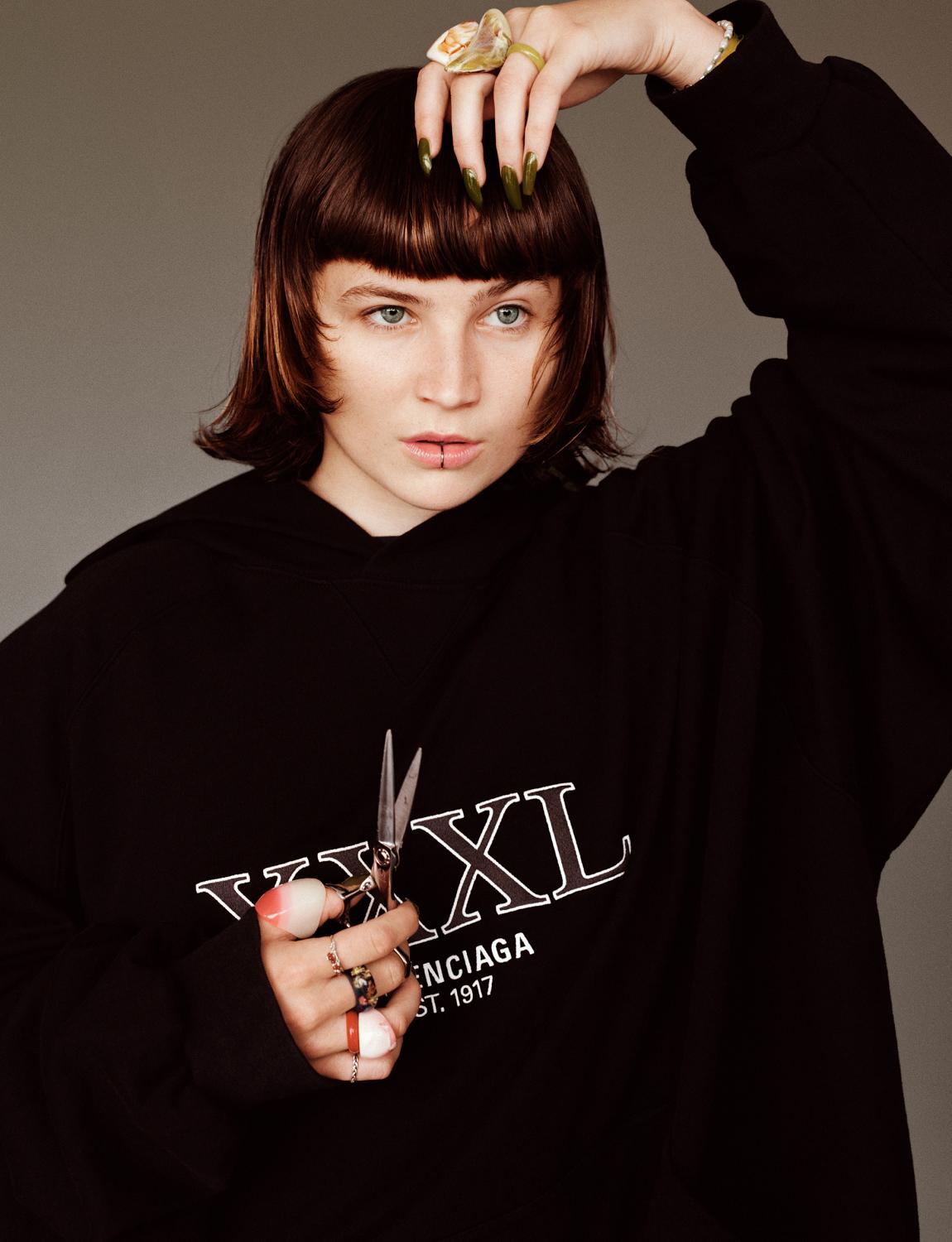
Portraits by Alasdair McLellan
Styling by Max Pearmain
Issue nº 26, Autumn and Winter 2022
This autumn looks to be Ísadóra Bjarkardóttir Barney’s season. The American-Icelandic actor, musician and maker of short films is entering her third decade on the back of her debut role in The Northman and an advertising campaign — she’s the new face of Miu Miu jewellery. “When the curtains rise or the cameras roll, I become hyper-present,” the chatty 19-year-old says. Away from silver screens and silver wares, Doa is a conscientious student with a job in her local record shop and a sideline in cutting hair.
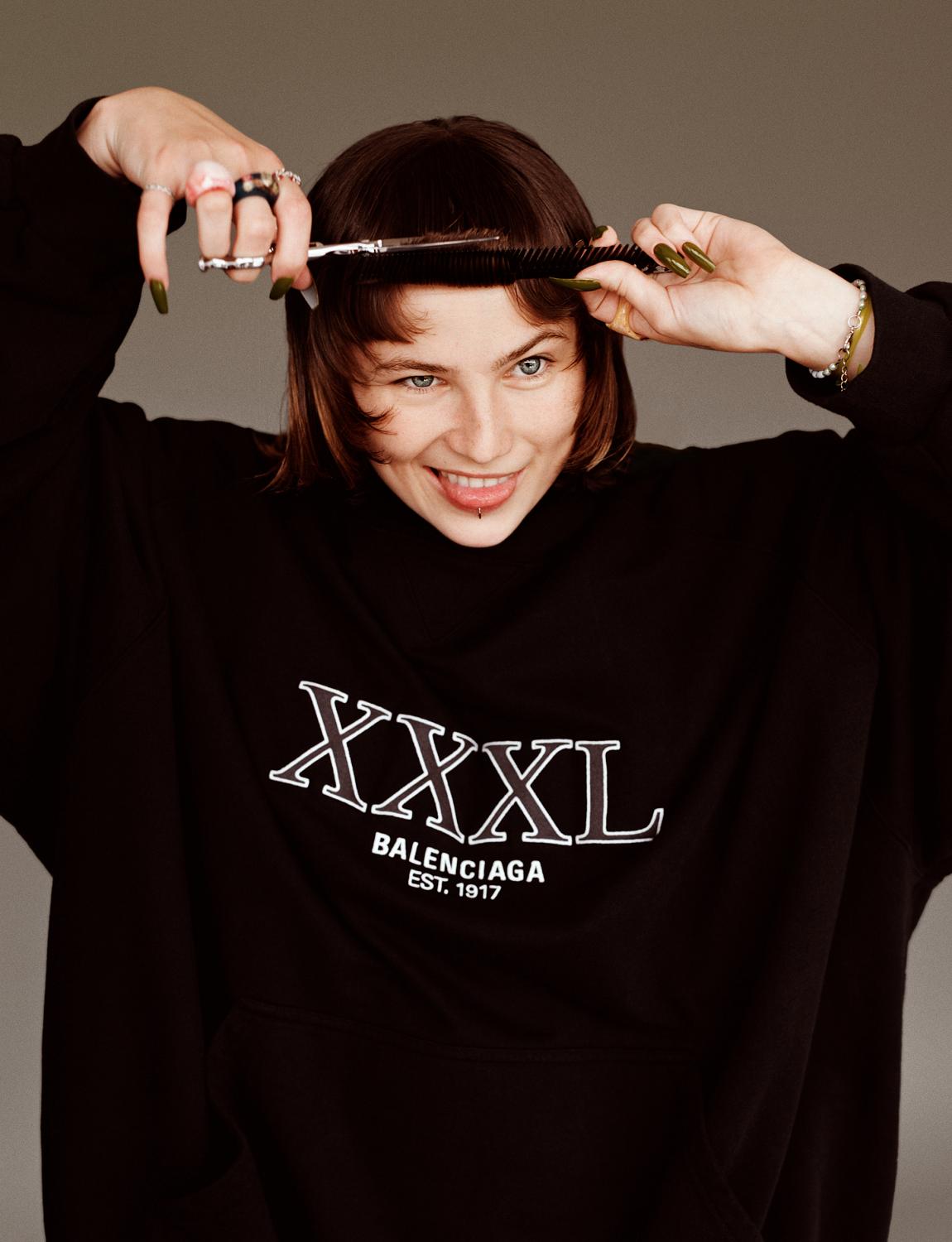
When I walk into the foyer of the luxurious Paris hotel at which Doa Barney has apparently just arrived, there is a group of people in a formation — cameras, clipboards, hierarchical vibe — that seems to imply fashion and its wider world. I scan them for signs of Doa. One young woman, who appears to be their centre of gravity and might well be 19, has a constellation of piercings. I lurch forward before realising this is not Doa. Then I spot her, apparently unrelated to all this: someone who, with her frayed brown jumper and bulging backpack, could be en route to a music festival. Her warm smile comes with a flash of rose-gold tooth grills.
Doa Barney is an actor. Earlier this year, she appeared in her first feature, Robert Eggers’ Viking revenge movie, The Northman. She is also a maelstrom of imaginative ideas and creative production who made a beguiling short film entitled Almanak and sings with disarming intricacy, making music that nobody has ever heard before. Whatever she does is greeted with a lot of interest and expectation, and this is, to use a Northman-circling cliché, a double-edged sword. She is daughter to a pair of towering cultural figures, is the thing: the Icelandic singer Björk and the American artist Matthew Barney.
Doa is in Paris, “doing a little campaign,” she says, shooting for a day before returning to Reykjavik, where she lives in the ground-floor flat of her mother’s house. “I’m rooted in Iceland,” she has said. “That’s where I am at the most creatively fertile.”
Ísadóra Bjarkardóttir Barney was born in London in 2002, the second child of Björk (who has a son, Sindri, now 35, with the Sugarcubes guitarist, Þór Eldon), and Barney’s first. From the start, her life was split between a flat in the West Village in New York and a stucco house in Reykjavik. Doa went to two kindergartens, two elementaries, and two middle schools. “My whole life, I’ve always been missing a home,” she says. “I felt like I was between the two lives.” The result, as the photographers Inez van Lamsweerde and Vinoodh Matadin put it, emailing from New York, is someone who is “a true cultural mix between her American and Icelandic parents.”
Throughout her childhood Doa was what she calls a “theatre girl”, and by 15 or 16 she had decided she wanted to be an actor, inspired by the groundbreaking theatre department at her school, Saint Ann’s in Brooklyn. “We did strange plays and had the best, weirdest teachers,” she says. “Even then I didn’t really believe I could see it through. Everything changed when I got a lead role in the school play in senior year.” That same year, she auditioned for The Northman. “My mother introduced the co-authors of the script, Sjón and Robert Eggers, when Eggers was visiting Iceland. When she heard they had written a script, she asked if I could audition. Luckily they said yes!” Doa says, laughing.
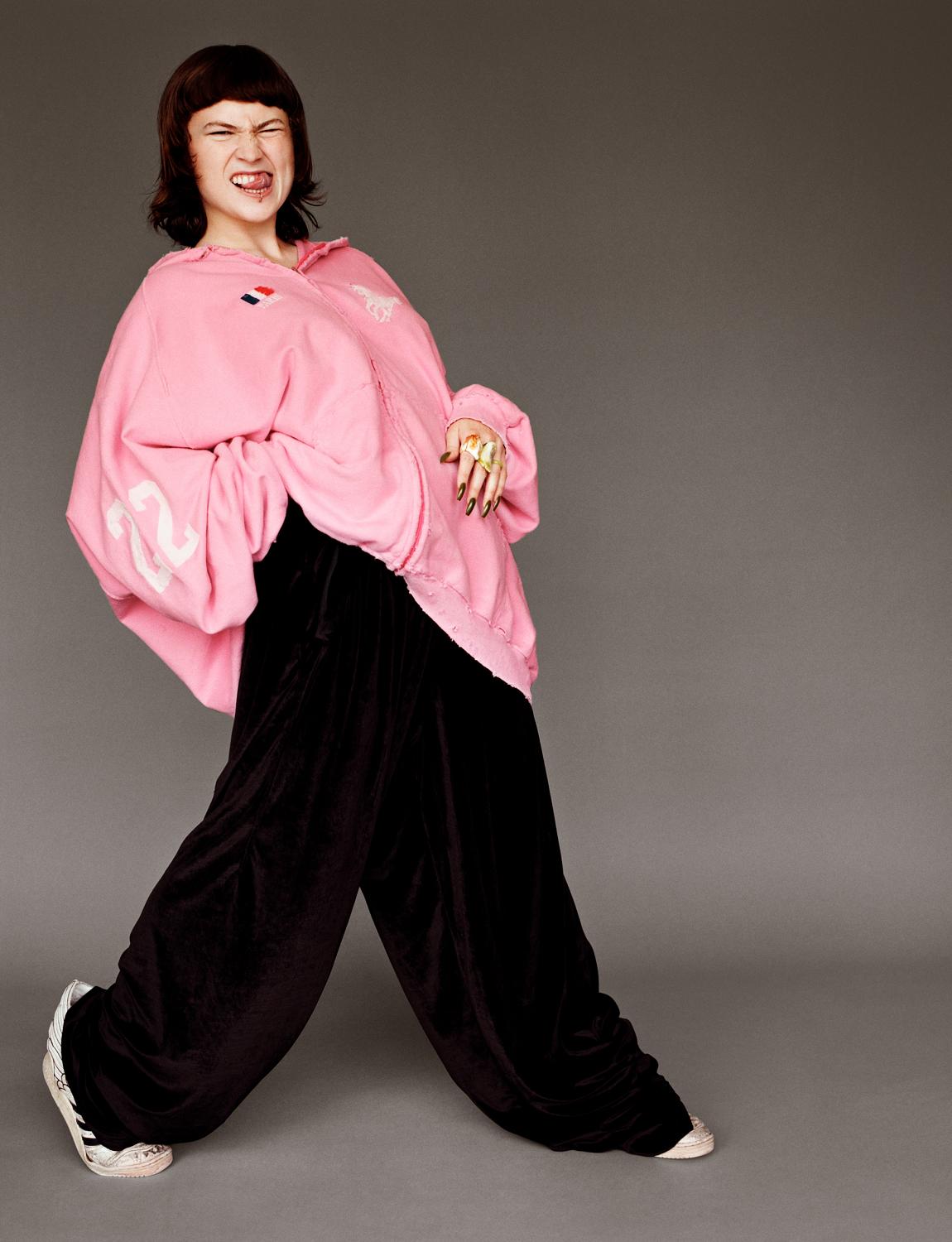
Doa was photographed wearing items by BALENCIAGA during a brief trip to London between stops in Paris and New York.
The Northman is incredibly atmospheric, a wet, cold, violent film doused in a sense of the cheapness of life. Much of its visceral ambience is due to the density of Eggers’ and Sjón’s background research, which pummels every scene, every garment, every line. This sense of oppression surrounds not only the film’s core stars — a brooding Alexander Skarsgård, a frostily enigmatic Nicole Kidman — but the wider cast as well. Doa portrays Melkorka, a garland-sporting Irish slave who leads a pagan song rite at a forest orgy. “I kind of imagine that she’s been on this homestead for most of her life, maybe doesn’t really remember the kidnapping or whatever happened to her,” she says. (Björk makes a cameo, as an enigmatic seer.)
The Northman was originally due to be filmed in Northern Ireland in mid-2020, before Doa had even finished school. But then the pandemic struck, and it was delayed until late 2020. “Shooting was intense,” Doa says. It was the first time she’d lived alone. It also coincided with a Covid lockdown, which meant that she found herself spending a lot of time in a hotel room in Belfast “just kind of staring out the window”. This was not necessarily a catastrophe as far as the shooting process was concerned — “I think it created a really interesting dynamic that we were so isolated and in our own heads when we were not working” — but it took its toll on an individual level. “To be completely transparent, I was in a circumstantially provoked depression,” Doa says.
One day her mother called. “It was 1pm or something. She was like, ‘You’re in bed, aren’t you?’ And then she tricked me into thinking that there was this huge favour I was doing for her. ‘I have a request for my birthday. Could you write me a script and then perform a little one-woman-show thing?’” (It should perhaps be noted that Doa has a tradition of offering her parents artistic or performative birthday presents; for her father’s 50th in 2017 she delivered a monologue in a mixture of Greek and English.) “At that point I was, ‘I’m so over theatre; that’s a high school thing.’ So I said, ‘How about this? I’ll make you a short film.’ And she was like, ‘Perfect.’ I had a month until her birthday in November, and I’d been taking the same walk along the River Lagan every day, taking short clips and photos. I just kind of pieced them together.”
That film became Almanak, a nine-minute short soaked in the solitude of lockdown — surreal self-examination, dirty baths, brutalist wanderings, Lynchian velvet curtains — with a soundtrack by the Welsh electro artist Kelly Lee Owens and the American shoegazer Alex G. “I sent it to her over email with a note, we talked on the phone, and she expressed her gratitude after I wished her a happy 55th. It was sweet, given that I can’t really offer her much other than things I create.
“It’s such a strange thing to have out, a little archival piece of my adolescence.” Between Doa’s personal YouTube channel, to which she has uploaded almost nothing else, and at least one unofficial repost on a Björk fan account, Almanak has accrued tens of thousands of views. “It still feels private. Other people have seen it and had thoughts, but I don’t think that infringes on how it was a cry out to my mom.”
The Northman had a “black-carpet premiere” at the TCL Chinese Theater in LA in April. “That was cool,” Doa says. “But watching the film itself was intensely emotion-evoking. I had feelings coming up that I didn’t really know I had for it — others beyond ‘Whoa, I’m in a movie.’ I feel like I can say that, even with little experience, it was a tough thing to do. And seeing it captured in 4K, at the Chinese Theater, I was like, I remember that day. That was the loneliest I’ve ever been.”
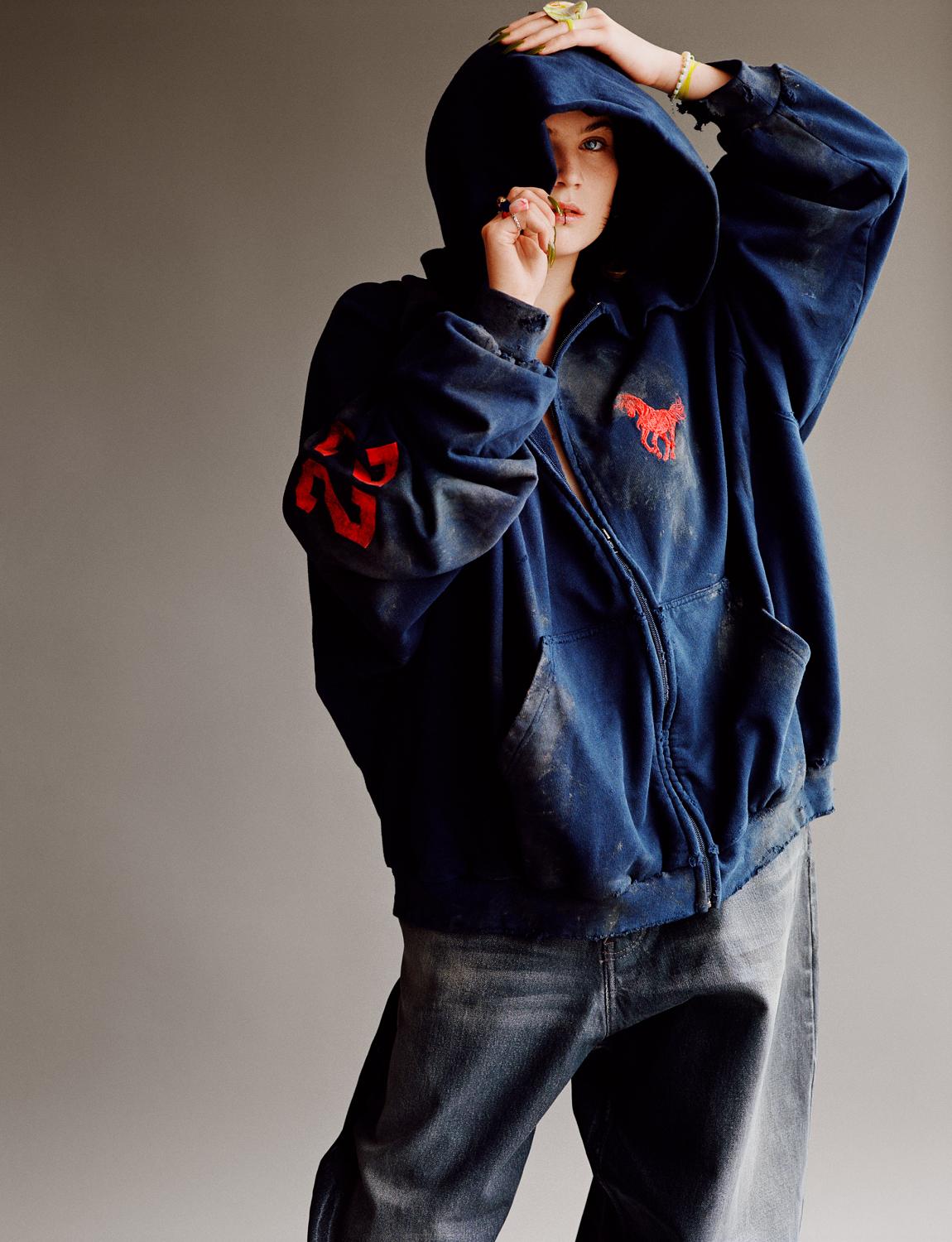
“I don’t know what’s at the end, but I’m really enjoying this casual stroll, building up connections in an organic way.”
After filming finished on The Northman, Doa enrolled at Pitzer College, a liberal arts institution and one of the prestigious Claremont Colleges in Southern California. Pitzer allows students to design their own programmes of study. “You can do anything you want,” Doa says. The courses she chose included Spanish, film, corporeal mime and the history of economic thought, with the idea of “ultimately focusing on acting”. She has now decided to do that. “I don’t know what’s at the end,” she says. “But I’m really enjoying this casual stroll, building up connections in an organic way and not through nepotism, which I definitely have. I have a lot of privilege when it comes to what I’m doing right now; I want to be mindful of it.”
She is referring to her day of shooting in Paris for the Miu Miu jewellery campaign, a collaboration between the brand and the Swedish artists Nathalie Djurberg and Hans Berg. You can see why they picked her. “The stylist Lotta Volkova had wanted to work with Ísadóra for some time. I love it when things just click,” Hans tells me by email from London. “Her personality, playfulness, courage shines through,” Nathalie, who is based in Ålingsas in Sweden, added.
Doa’s Instagram selfies (@d0lgur; 23,300 followers) often feature some intriguing conjunction or other: rings on fingers; one through the lower lip; chains and bolts laid out across the face like an alien treasure map. In Djurberg and Berg’s video for the campaign, flowers, birds and a slightly creepy hand all nibble at Doa’s Miu Miu jewels in stop-motion animation as she gamely feigns mock surprise. “Ísadóra has a chillness, like a child who knows how to get away with stealing a cookie,” Nathalie said. “Hans and I were jokingly saying how terrified I was of seeming stupid, going from working in solitude to working with 50 people on set, and Ísadóra said, ‘My goal is to be as stupid as I can be when I grow up.’ That really saved my day. I love unafraid people.”
Faoileann Cunningham, who plays Kormlöth in The Northman, also told me, by email from County Meath, Ireland, where she was prepping for a shoot, that Doa has a fearlessness and an endless curiosity about life. “Her energy is quietly infectious, magnetic. She’s an incredibly generous spirit — and a wildly fun friend.”
Today, tooth plates aside, Doa is uncharacteristically bereft of all her rings and piercings, but when I mention it, she excitedly produces them from a bag and begins to rearm herself. She starts with brightly coloured rings bought “in San Francisco at some really kooky kind of costume store that’s really, like, queer-coded.” She segues into a meditation on the right to be difficult, delivered in an accent that is mostly East Coast American, but with subtle Icelandic cadences. “So entering anywhere with these rings, I’m so loud, and that also feels like I take up a bunch of space. My recent obsession is with being really inconvenient and impractical.”
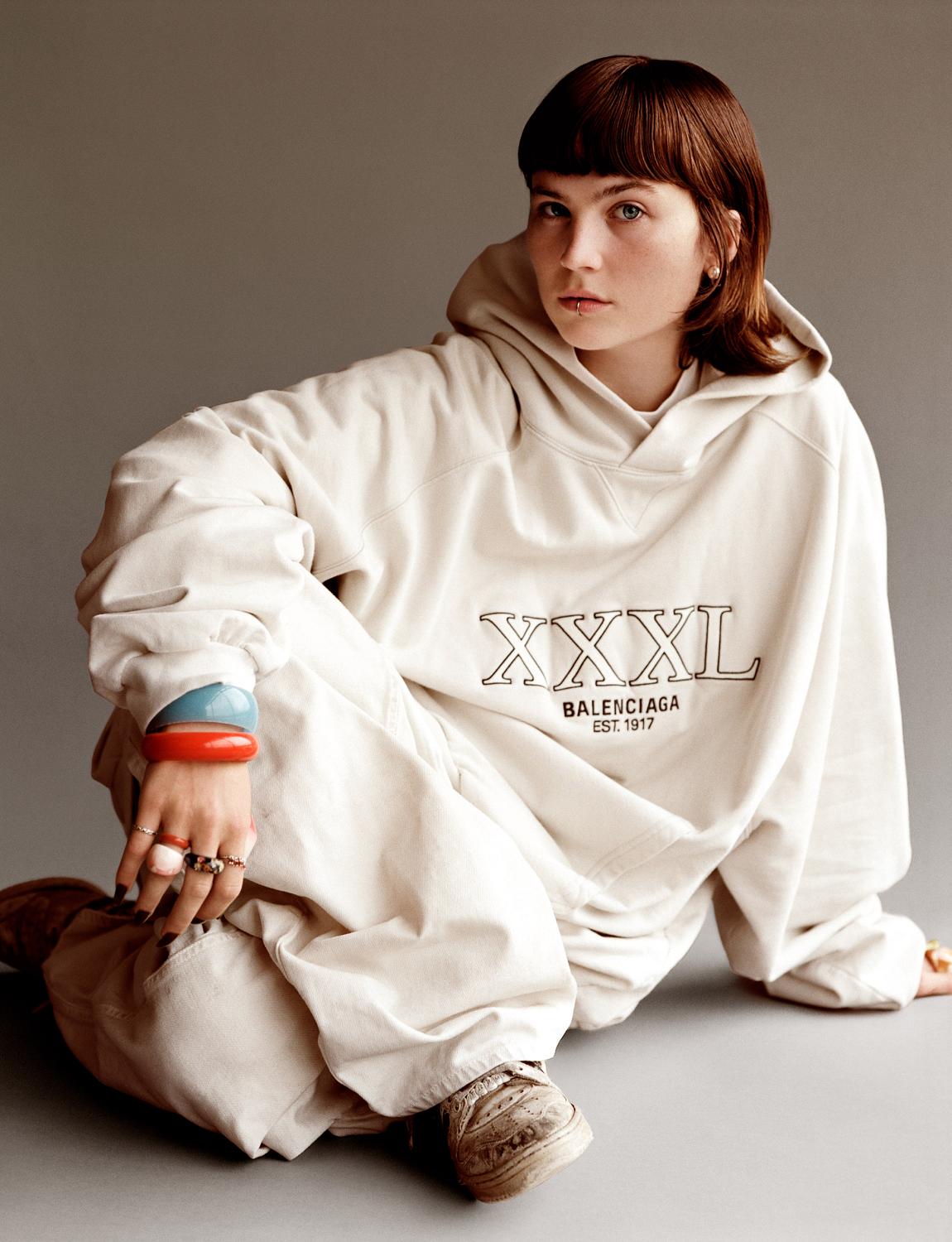
“Entering anywhere with these rings, I’m so loud, and that also feels like I take up a bunch of space.”
When Doa was 11, Björk and Matthew Barney separated after 13 years together. The split was acrimonious and resulted in a custody battle (and a memorable track on Björk’s 2017 album, Utopia, “Sue Me”). Doa escaped most of the publicity, she told The Face magazine earlier this year. “Luckily, my parents are pretty niche when it comes to their audience!” she said. “Fellow 11-year-olds weren’t really listening to Björk or looking at Matthew Barney’s art. So it wasn’t like my peers were conscious of it.” It was only several years later that she became aware of all that had happened between her parents, “and then it was interesting to have this record of a really painful time.” She added, “I think it helped humanise the situation. And that’s what artists do.”
As a child, Doa was exposed to the processes of two of the most prominent artists in the world, and arguably — at least in her musical appearance in The Northman — she hasn’t strayed that far from a kind of personal refraction of Björk’s world of music and Barney’s realm of dark, fantastical filmmaking. Of course, she is not just a consumer of their work but part of it, overtly or otherwise. What does it feel like when her mother sings a song about her? “When I watch her concerts and she sings ‘Mouth’s Cradle’ or ‘Tabula Rasa’, it feels private,” Doa says. “Even if I’m in a huge room full of people. Because it’s like a little wink, a little secret between us, the words she chose and even the melodies. Because she’s such a mathematician when she writes and chooses words carefully that match the melody.”
Doa’s own music mostly remains in a hermetically sealed box. Her sole available recorded output is a cover included on the compilation Songs We’re Sung, curated by her friend Oliver Devaney, an accordion player, to raise money for Refugees International. Each song is one the artist either had sung to them by their parents or was strongly influenced by in childhood.
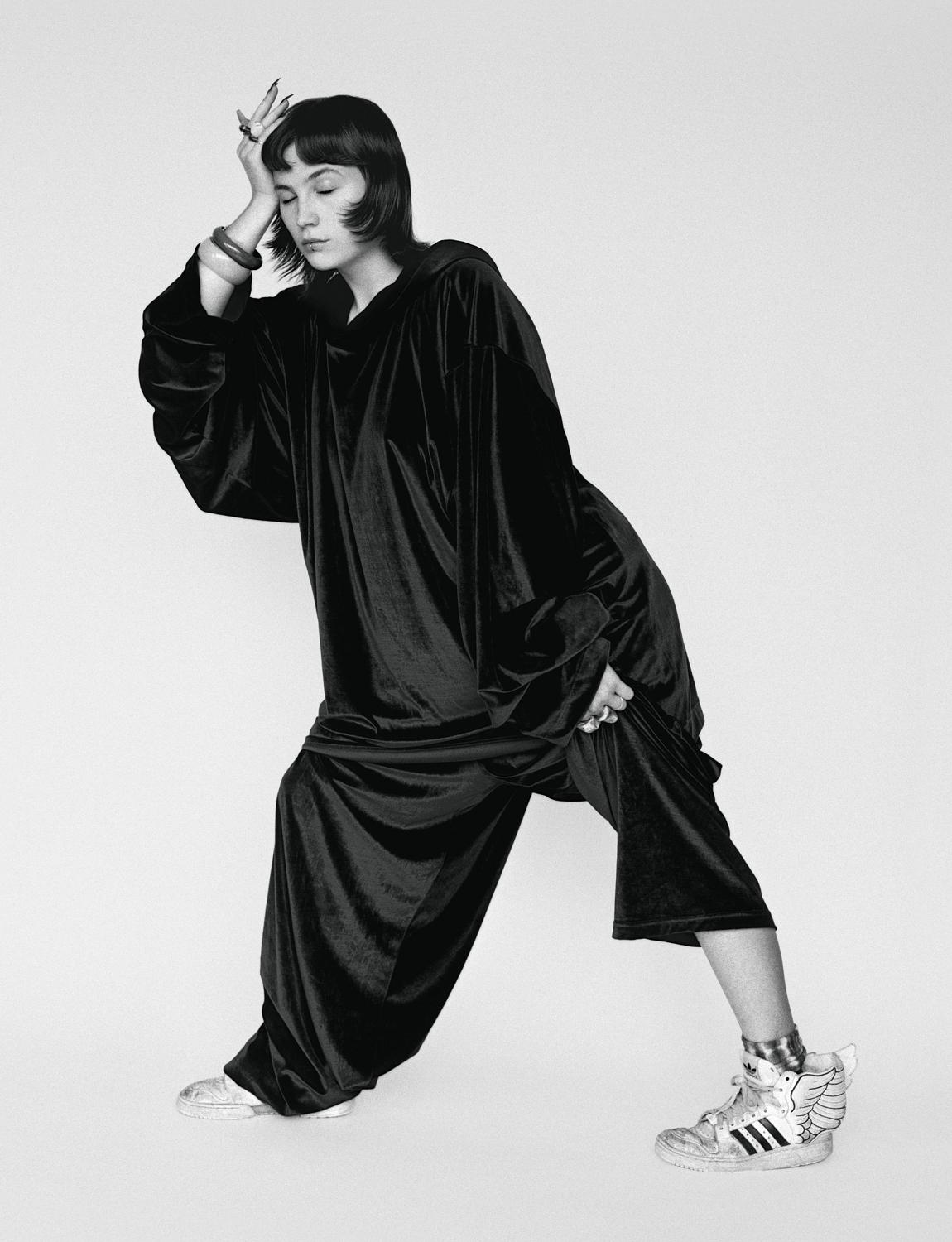
Doa’s go-to audition speech is one of Con’s monologues from Aaron Posner’s Stupid Fucking Bird, an adaptation of Chekhov’s The Seagull. “Directors usually ask for a Shakespeare too. I do Othello, Ophelia. It’s a classic; you can’t beat it!”
To explain her contribution, Doa recalls a story. When she was about 16 she became haunted by a tune, “just a tiny little melody.” She knew she’d heard it before but couldn’t remember when or where. She researched it online. She downloaded apps. “But I had so few notes that it didn’t amount to anything. And then I sang it to my mom and my dad, and my mom was like, ‘No, I don’t know.’ And weeks passed, and finally she was like, ‘Oh. It’s this.’”
The song Doa had been questing for was “’81” by the Californian singer-songwriter and harpist Joanna Newsom, about retreating to a version of the Garden of Eden. “I remember then playing it, and instantly returned to this eight-year-old zone of listening to it all the time.” Her tribute is divine, the arrangement unfussy but full of warmth, her voice exposed but overflowing with kindness. She mentions Newsom’s name when listing her comfort music, the stuff she always goes back to, alongside Kate Bush’s and Kendrick Lamar’s respective albums Never for Ever and To Pimp a Butterfly, and traditional Icelandic songs as performed by the choir of the secondary school both she and her mother went to, Hamrahlíð College.
At home in Reykjavik, she plays with friends in a “noisy indie” band called FOOD, its name sourced from the first initials of its four members. It is run according to a constraint whereby, during improvised rehearsals, neither chords nor lyrics can be changed once they have sprung into being. “I have a feeling it’s not going to see the light of day,” she says. “I really like what we made, but a part of me wants to be kind of punk and not release it. And there’s something quite nice about this little stowaway secret.” It’s part of a wider cache. “I make a lot of music which nothing happens to. My mom hears it.” Does she offer constructive criticism? “Absolutely. Yes. Very constructive. I always trust what she says, because it’s not just like, ‘Oh, everything you do is amazing, my daughter.’ No, she critiques. I don’t think I could ever be, like, a touring musician, though. I don’t think I have that in me.”
Is there any chance she might take a lead from her father’s work and become a visual artist? “That would be interesting, wouldn’t it? I mean, I have these connections to both music and visual arts that are like home. They mean home to me.”
Back in Reykjavik, Doa works in a record shop called Smekkleysa (“bad taste”), updating the store’s social media and occasionally booking DJs, often from her network of friends. She is, says the general manager, Benedikt Reynisson, “a bearer of positivity and good vibes. When she feels something is missing, she normally makes it happen. The ‘Now Playing’ stand was made by her, and when you see that all the merch has been folded and taken care of, then you know she was working.”
Smekkleysa is an on-off thing, of course. She travels so much. This summer, she has spent time in Barcelona with friends at the Primavera Sound festival; in Iceland with her family and some US friends “at a punk DIY musical festival, Hátíðni, in the north — very interesting to see my US and Iceland worlds collide”; in Idaho “with my dad’s side, hiking, baking, fishing”; in Paris to see Björk’s show; in New York. Then Paris again, New York again, Los Angeles, London “to meet my mom”, and back to Iceland. Not all of this was for fun; she was also working — as she has done since she was 14 — this time for Miu Miu as well as acting in Hugo Comte’s upcoming short and helping her father with a project.
She is planning to apply to drama school. “I’m excited about the Lecoq school in Paris, as well as a Noh theatre programme in Kyoto.” She will also apply to Juilliard, “because can I really say I’m a drama kid if I don’t? I’m determined to get as holistic of a performance education as I can, leaving no rocks unturned.”
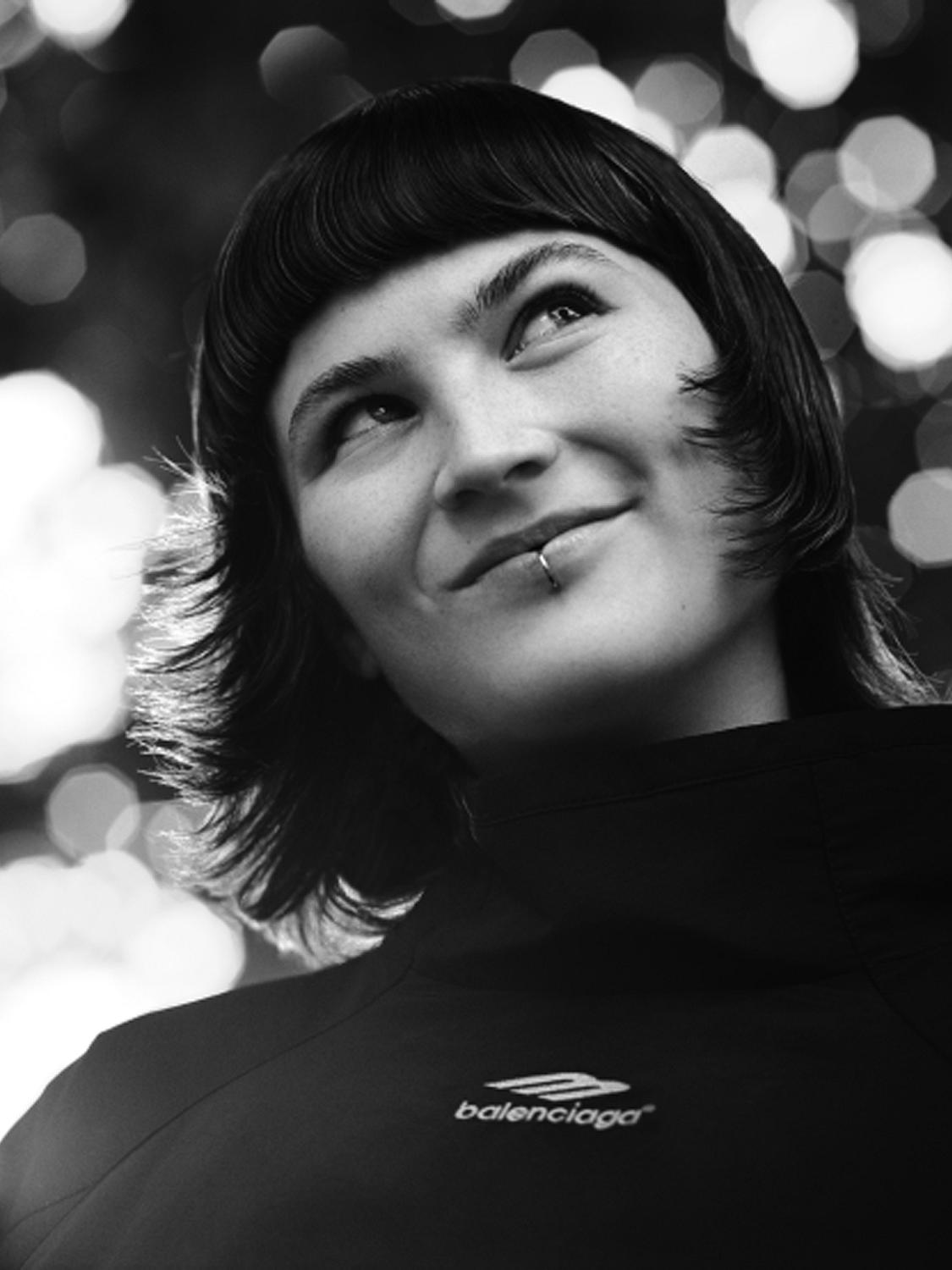
Seb EminaWiltshire-born Seb is the instigator of sonic projects including Global Breakfast Radio (2014), which aggregates real radio from wherever the sun is rising, and this year’s Wild Memory Radio, an audio museum of artists’ memories, for WePresent. Formerly the editor-in-chief of The Happy Reader, Seb…read more Portraits by
Alasdair McLellanOne of the leading fashion photographers working today, Alasdair McLellan is noted for his warm, intelligent portraiture, which has featured in Fantastic Man, Self Service, multiple Vogues and Love, among many other quality titles. Originally from Doncaster, Alasdair is a fan of 1980s super-producers…read more Styling by
Max PearmainMax Pearmain is a London-based stylist from Norwich. His prolific career in fashion started out on the runways of Paris as Hedi Slimane’s favourite mannequin during those heady days of Dior Homme in the early 2000s. Now Max makes and shapes the fashion world himself as one of its most in-demand stylists,…read more
Hair: Kim Rance at LGA Management. Make-up: Anne Sophie Costa at Streeters. Manicure: Jenny Longworth at Streeters. Lighting: Declan Fitzgerald. Photographic assistance: Lex Kembery, Simon Mackinlay. Styling assistance: Emma Simmonds. Production: Art Partner.
This profile was originally published in The Gentlewoman nº 26, Autumn and Winter 2022.